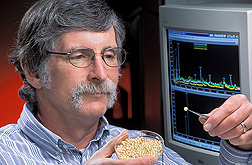This page has been archived and is being provided for reference purposes only. The page is no longer being updated, and therefore, links on the page may be invalid.
Read the magazine story to find out more. |
|
|
ARS Scientists in North Dakota Help Improve Potato Storage Capabilities
By Jan SuszkiwMay 6, 2010
Agricultural Research Service (ARS) scientists in North Dakota are evaluating the storage properties of promising new potato varieties that could greatly improve potato quality for growers throughout the United States.
Seventy percent of all potatoes in the United States are processed into chips, french fries and dehydrated potato flakes. Maintaining adequate potato storage quality for processing—in some cases, up to 10 months—is vital to potato producers and processors.
Jeff Suttle, research leader at the ARS Sugarbeet and Potato Research Unit in Fargo, N.D., and food technologist Marty Glynn at Fargo's work site in East Grand Forks are working with the Northern Plains Potato Growers Association and public potato breeding programs throughout the United States to evaluate the storage properties of new potato varieties.
Their evaluations of the new varieties over the past year have led to the development of two named cultivars, "Dakota Crisp" and "Dakota Diamond," which fare well even after nine months of storage.
Wound-healing and sprout control are both major issues for potato storage managers. Potatoes are sometimes damaged during harvest and must heal in order to prevent infection by other pathogens. The internal processes that control wound-healing are being determined in studies by ARS chemist Ed Lulai in Fargo. Lulai has identified hormonal signals that stimulate the healing process.
When potatoes are harvested, they're dormant and don't sprout. During storage, dormancy ends and sprout growth commences. Sprouting results in numerous biochemical changes, which are detrimental to the nutritional and processing qualities of potatoes. Postharvest sprouting is typically controlled during storage with chemicals that inhibit the process.
The long-term goal of Suttle's program is to find less costly, nonchemical solutions to the problem by identifying the genetic cause for these early-sprouting tubers. The researchers have identified internal mechanisms that signal sprouts to grow, and they are currently isolating the genes responsible for these signals.
Read more about this research in the May/June 2010 issue of Agricultural Research magazine.
ARS is the principal intramural scientific research agency of the U.S. Department of Agriculture (USDA). The research supports the USDA priority of promoting international food security.

